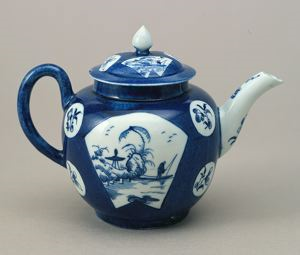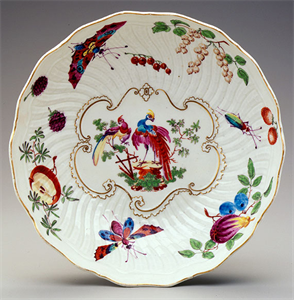
Worcester Porcelain Factory
English, born established 1751
The powder blue ground on this teapot was a Chinese invention first used on English delft ware and on porcelains created by the English manufactory, Bow, during the 1750s, and then introduced at Worcester around 1760. The Chinese-style pattern on the MMFA teapot appears to be transfer-printed and is called "The Fisherman in a Fan-Shaped Panel". It was used on a wide range of shapes, primarily teawares, between 1760 and 1770.
The teapot is marked on the base with an underglaze-blue open crescent and fretted square. During its early years Worcester occasionally marked its wares with factory symbols in underglaze blue. The crescent shape, first introduced around 1757-58, was adapted from the arms of the Warmstry family whose house was one of the sites of the Worcester factory. Factory symbols often were taken from or mimicked by other ceramic houses so they are not a guarantee that a piece was manufactured by Worcester. Worcester was part of a complex, aggressive, international industry that did not consider it inappropriate to fool the public into thinking it was buying one type of ware when in fact it was buying that of another factory.
English, born established 1751
Teapot and Cover
about 1760–1765
Object Type:
Ceramic
Creation Place:
Northern Europe, English, Worcestershire
Dimensions:
5 1/2 in. x 7 1/2 in. x Diam: 4 1/2 in. (13.97 cm x 19.05 cm x 11.43 cm)
Medium and Support:
Porcelain
Accession Number:
1997.0007.0002 ab
Credit Line:
Gift of Mr. and Mrs. James Lucien Loeb
Currently On View
The powder blue ground on this teapot was a Chinese invention first used on English delft ware and on porcelains created by the English manufactory, Bow, during the 1750s, and then introduced at Worcester around 1760. The Chinese-style pattern on the MMFA teapot appears to be transfer-printed and is called "The Fisherman in a Fan-Shaped Panel". It was used on a wide range of shapes, primarily teawares, between 1760 and 1770.
The teapot is marked on the base with an underglaze-blue open crescent and fretted square. During its early years Worcester occasionally marked its wares with factory symbols in underglaze blue. The crescent shape, first introduced around 1757-58, was adapted from the arms of the Warmstry family whose house was one of the sites of the Worcester factory. Factory symbols often were taken from or mimicked by other ceramic houses so they are not a guarantee that a piece was manufactured by Worcester. Worcester was part of a complex, aggressive, international industry that did not consider it inappropriate to fool the public into thinking it was buying one type of ware when in fact it was buying that of another factory.
Keywords
Click a term to view the records with the same keyword
Portfolio List
Click a portfolio name to view all the objects in that portfolio
This object is a member of the following portfolios:
Your current search criteria is: All Object records.

 by Artist (743)
by Artist (743)
